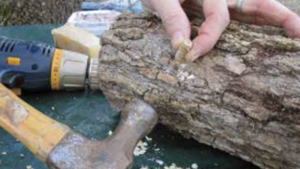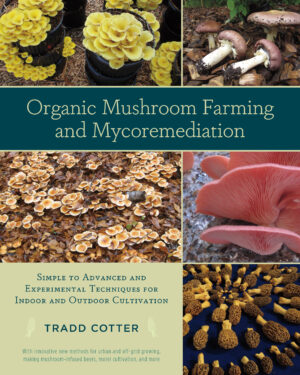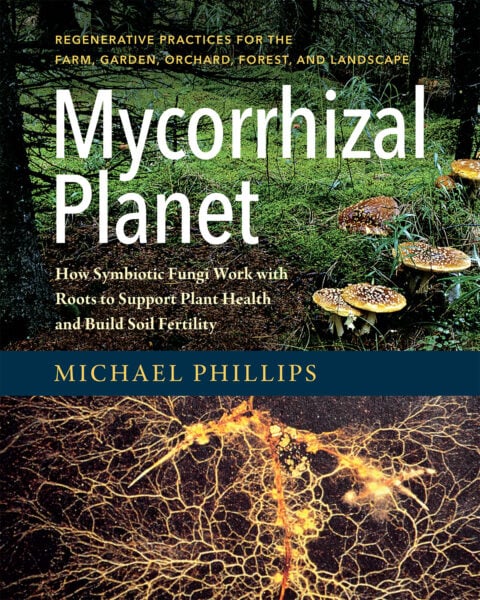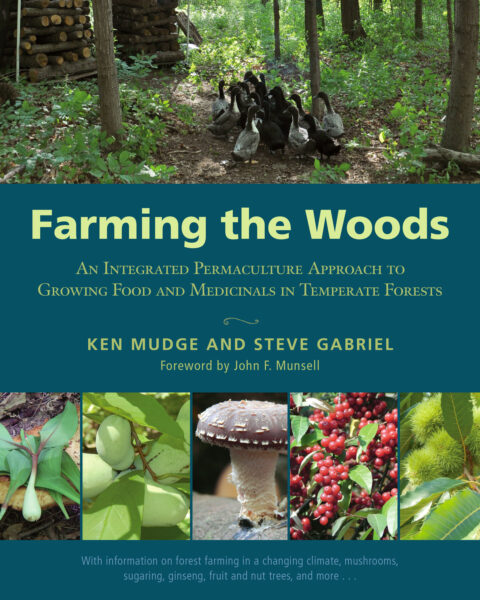Drill, Plug, Wax, Wait: 6 Simple Steps to Growing Mushrooms Outdoors
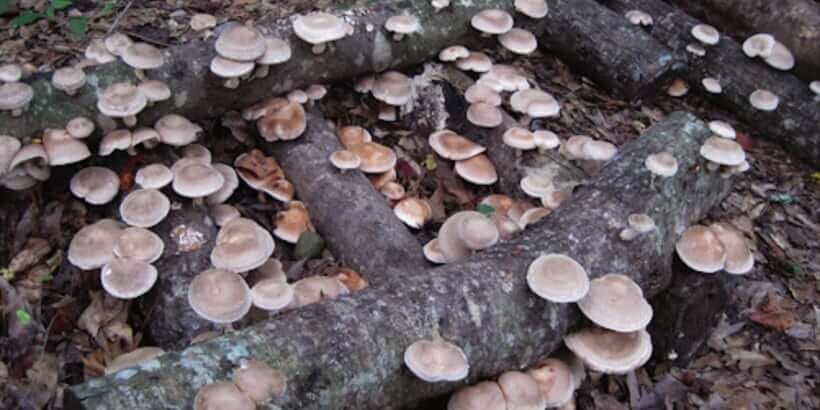
Growing mushrooms outdoors just got even easier! Learn about growing mushrooms on wood, from logs to tree stumps, with this simple six-step tutorial.
The following excerpt is from Organic Mushroom Farming and Mycoremediation by Tradd Cotter. It has been adapted for the web.
Log & Stump Mushroom Cultivation

If you are using plug spawn, match the depth and diameter of your holes to your plugs. If you are using sawdust spawn, you may need a slightly larger diameter depending on the tool you use to insert the sawdust.
People have been growing mushrooms on logs and stumps for hundreds, possibly thousands, of years. It is one of the simplest ways to cultivate edible and medicinal forest mushrooms such as shiitakes, maitakes, and oysters. In fact some mushrooms, such as maitakes, are easier to grow outdoors under natural conditions than indoors.
Outdoor log and stump cultivation is generally low-tech, but when practiced on a large scale it requires a lot of initial labor in getting the logs or stumps set up. For this reason the log-grown mushroom industry has developed more quickly in countries where labor is plentiful and inexpensive and the technologies required for indoor cultivation are limited.
Overall, I don’t recommend outdoor log and stump cultivation for commercial enterprises. It is better suited for home-scale and hobby growing, or as supplemental income for a small commercial enterprise.
Stumps vs. Logs: Where to Start
Cultivating mushrooms on stumps is similar to cultivating them on logs, although if you are a beginner, I recommend starting with logs, since stumps can take many years to fruit. (Once they start, they can fruit for a decade or more.) You use the same inoculation techniques, such as drilling and plugging with dowels or sawdust spawn.
The main difference is that you plug as much of the visible barked wood that remains aboveground as possible and you also spawn the outer ring of the top, cut face of the stump. Many mushrooms, such as maitakes, chicken of the woods, reishis, enoki, oysters, and beefsteaks, benefit from stump rather than log cultivation.
Growing Mushrooms Outdoors: A Step-By-Step Process
Step 1. Cut your logs into lengths that are easy to handle and carry. The most common lengths are between 2 and 4 feet, depending on how much weight you, or the people who are helping you, can carry. And aim for a diameter for 6 to 10 inches. Since you may be picking these logs up often, choose a size that best suits your strength and abilities.

Use a diamond drilling pattern all the way around the barked surface of the log. Closer spacing will speed up colonization, but I suggest spacing the holes 4 to 6 inches apart.
Step 2. Next you will need to drill holes into the log at regular intervals at a depth of about 1 to 11/2 inches. Most plug spawn on the market call for a 5/16-inch drill bit, although this can vary; just match the drill bit to the plugs you’re using. If you’re using sawdust spawn, match the bit to the size of the packing tool you’re using.
A high-speed drill bit attached to an angle grinder with an adapter can be well worth the investment if you are inoculating a large number of logs. The higher rpm and speed makes drilling logs effortless compared to a regular electric power drill.
Drill your holes in a diamond pattern, all the way around the bark-covered surface of the wood, spacing the holes about 4 to 6 inches apart. Drilling and spawning more holes will not produce more mush- rooms, but it will speed up the colonization process for earlier fruiting. I would not advise spacing your holes farther than 6 inches apart or you increase the risk of attracting spores from competing fungi. This doesn’t “hurt” the mycelium you spawned, but it will reduce your yield by taking valuable real estate away from your culture.
Step 3. Insert spawn into each hole, tapping with a hammer if you are using plugs or tamping with a dowel if you are using sawdust. Fill the hole until the spawn is flush with the bark. Brush a small amount of melted wax over the spawned hole to seal in the spawn. Wax helps maintain moisture in the hole, supporting the mycelium as it drills its way outward from the sawdust or plug into the walls of the freshly drilled holes.
Some growers also wax the ends of their logs to lock in moisture, but that can also lock it out. Another option is to wax one end and not the other, allowing moisture to wick in the unwaxed side during rainfall, during an overnight soak, or when it comes into contact with the moist ground.
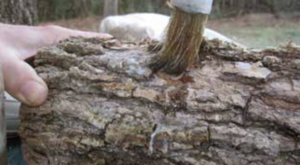
Cover the plug with wax to preserve the moisture and keep contamina- tion and insects out. This gives the mycelium enough time to drill its way into the cavity and begin colonization.
Step 4. Situate the logs in a shady area with dappled forest light, or on the shady side of a building if you’re in an urban environment. Locate them near a water source for easy watering and soaking when necessary.
The colonization phase can take six to ten months, depending on the type of wood, temperatures, and spawn spacing. Visit the logs periodically—at least once a month during the first six months. The wax you applied may disappear or crack and fall off, which is fine since the mycelium really only needs just a few weeks of protection after spawning.
Dry conditions can slow colonization, so lightly water the stack once a week or so to maintain moisture if it has not rained. Pick up a few of the logs to feel the weight; if they are extremely dry and seem much lighter than they were at spawning, you may want to soak them overnight with water—but for no longer than twenty-four hours, or the mushroom mycelium can drown.
Submerge the logs in water in a trash can, large plastic tote, or cheap baby pool. Use other logs or bricks to weigh down the logs, keeping them completely submerged.
Another alternative is to mist them gently over a period of a week or more, to gradually allow the logs to wick in moisture. This option can waste water, however.
Step 5. About six months after inoculation, start inspecting the log ends once a week for signs of mycelium, such as white streaks on the open cut face, which signals that the mycelium is approaching full colonization and will soon be capable of fruiting. Optimum moisture is now more important than ever to ensure that the mycelium will be able to supply the growing mushrooms throughout the pinning and fruiting stages.
At this point, as the mycelia in the logs approach complete colonization, the stacked logs may begin to fuse together.
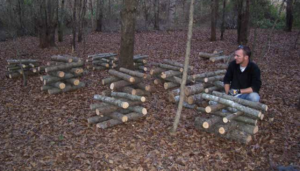
Stack your logs in a shady spot for colonization. I keep them stacked tightly together to preserve moisture while they are colonizing and then restack them in this open-air log cabin style once they show signs of fruiting.
Soak them overnight in water and then spread them out in a “log cabin” formation, or lean them against the trunks of living trees in a circular formation, with one end on the ground and the other resting against the tree.
Step 6. At long last, your mushrooms will begin fruiting. Logs will fruit two or three times a year, typically for as many years as they are inches in diameter, resting a few weeks in between each flush.
Mushrooms may fruit near the spots where you set the spawn on the first flush, because it is an easy escape, but they can also fruit from just about anywhere around the entire bark surface.
Once you notice baby shiitake mushrooms, which will split the bark and appear as dark brown to black buttons, mist them as much as you can; several times a day is ideal.
A misting system is preferred for commercial log production, or simply locate your logs near your home to mist them in the morning and evening as you pass them by.
If your logs have ground contact, check that area often, since they might direct their fruiting downward in the search for water. When the mushrooms have matured, it’s time to harvest!
Keep records of the flushing patterns and establish a schedule for watering that coincides with those patterns; this will not only increase yields but improve your understanding of the mushrooms you are cultivating. Once mushrooms are colonized and ready to fruit, they will be waiting for adequate water to support fruiting. Time the wa- tering for when the mushrooms have had enough rest and are fully charged to take advantage of the watering; this will give you the optimal fruiting with each flush.
Recommended Reads
Recent Articles
Chances are, you’ve seen cattails growing on the edge of your local lake or stream at least once or twice. Instead of just passing these plants, try foraging for and cooking them to create delicious seasonal dishes! The following excerpt is from The New Wildcrafted Cuisine by Pascal Baudar. It has been adapted for the…
Read MoreWith the right strategies and practices, composting on a small farm is surprisingly easy and inexpensive. Just follow these steps for making compost, and your farm will be thriving in no time! The following excerpt is from The Lean Farm Guide to Growing Vegetables by Ben Hartman. It has been adapted for the web. (All photographs by Ben…
Read MoreGarlic mustard: while known as “invasive,” this plant can be consumed in its entirety and has great nutritional value. Plus, the garlic-flavor is a perfect addition to any recipe that calls for mustard! The following are excerpts from Beyond the War on Invasive Species by Tao Orion and The Wild Wisdom of Weeds by Katrina…
Read MoreEveryone loves a refreshing, fermented, nutritious drink…even your garden! Take your fermentation skills out of the kitchen and into the garden by brewing fermented plant juice. The following is an excerpt from The Regenerative Grower’s Guide to Garden Amendments by Nigel Palmer. It has been adapted for the web. How to Make Fermented Plant Juice Fermented…
Read MorePeregrine falcons, while known as predators, are essential to our environment. These stunning birds have a rich history, an interesting present, and an uncertain future. The following is an excerpt from Feather Trails by Sophie A. H. Osborn. It has been adapted for the web. Who Are Peregrine Falcons? Though relatively uncommon wherever it occurs,…
Read More

